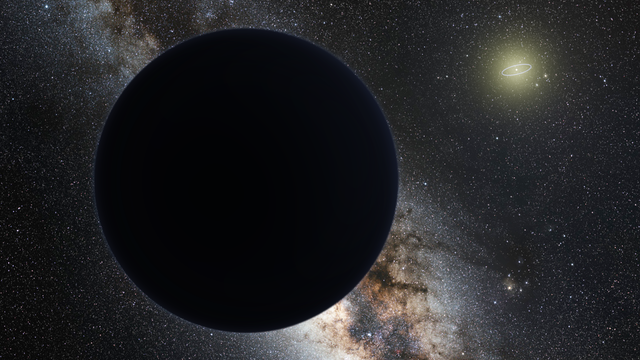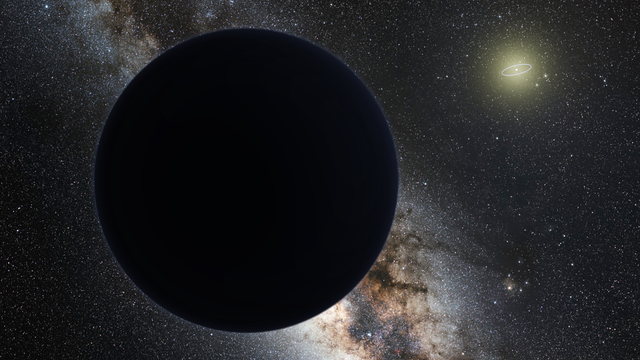
A potential new dwarf planet has been discovered in the outer reaches of the solar system, and its existence poses the greatest challenge yet to the hypothesis that a ninth planet lurks far from the sun.
“We were very excited to discover 2017 OF201 because it was not expected at all,” study leader Sihao Cheng of the Institute for Advanced Study in Princeton, told Space.com. “It’s very rare to discover an object both large and with an exotic orbit.”
“The object’s aphelion — the farthest point on the orbit from the sun – is more than 1,600 times that of the Earth‘s orbit,” Cheng explained in a statement. “Meanwhile its perihelion — the closest point on its orbit to the sun — is 44.5 times that of the Earth’s orbit, similar to Pluto‘s orbit.”
The outer solar system
We’re learning more and more about the outer solar system. Beyond Neptune is the Kuiper Belt; a ring of icy cometary nuclei and planetesimals dominated by Pluto and Charon. The Kuiper Belt begins about 30 astronomical units (AU) from the sun (one AU is the distance of Earth from the sun), its inner edge guarded by Neptune, and extends out to 50 AU. NASA’s New Horizons spacecraft is currently exploring the Kuiper Belt.
Meanwhile, the twin Voyager spacecraft have already sped through the Kuiper Belt and have entered a realm called the Scattered Disk, which is thought to go all through way out to more than 1,000 AU and is home to icy bodies on highly elongated and highly inclined orbits. These objects were literally scattered in the region through gravitational interactions with Neptune, and have had their orbits further modified via torques induced by the gravity of passing stars, or the “galactic tide” (the overall gravitational field of the Milky Way galaxy). Beyond the Scattered Disk is the Oort Cloud, which is an immense volume of space that possibly stretches up to a light-year from the sun and is the source of long-period comets.
However, much about the Scattered Disk is still unknown, and besides those long-period comets that venture this way every now and then, no Oort Cloud object has ever been seen — they are too far away and too small. This is why every discovery of a trans-Neptunian object (TNO) on a greatly elongated orbit is vital for piecing together the mystery of the outer solar system.
A new dwarf planet
Around 5,000 TNOs have been discovered until now, but the latest discovery may be one of the most important. Known as 2017 OF201, it is currently 90.5 AU away from the sun, but its orbit brings it as close as 4.14 billion miles (6.66 billion kilometers) from our star and as far away as a whopping 157 billion miles (244 billion kilometers). from the sun. For the vast majority of its 24,256-year orbit, 2017 OF201 is too far away to be seen with current telescopes; it could only be discovered because its last perihelion came in 1930, and that it’s still relatively close.
The object’s last perihelion also came, coincidentally, during the same year that Clyde Tombaugh discovered Pluto with a 13-inch (330mm) telescope at Lowell Observatory in Arizona. Would it have been possible for Tombaugh to have also found 2017 OF201? Probably not — at magnitude +20.1, this object would have been four magnitudes fainter than Pluto, and it is even fainter today.
Fortunately, telescopic technology has come a long way in the past 95 years, with deep surveys that can capture the passage of a faint object. For example, the Dark Energy Survey (DES) has identified about 800 TNOs — and that’s even though DES is ostensibly a cosmological survey. In the same vein, Cheng, along with Jiaxuan Li and Eritas Yang of Princeton University, have been scrutinizing observations made by the Dark Energy Camera Legacy Survey (DECaLS) on the Victor M. Blanco 13-foot (4-meter) telescope at the Cerro Tololo Inter-American Observatory in Chile. They discovered 2017 OF201 in archive data going back to 2017 from DECaLS, and also spotted it in old data dating from 2011–12 captured by the 11.7-foot) (3.58-meter) Canada–France–Hawaii Telescope on Mauna Kea.
Based on its brightness and its expected albedo of 0.15 (meaning it would reflect just 15% of the sunlight incident upon it), Cheng’s team calculated that 2017 OF201 is probably about 435 miles (700 kilometers)) across. This would make it the second largest object found on such an elongated orbit. Although it is substantially smaller than Pluto, which is 1,477 miles (2,377 km) across, 2017 OF201 is nevertheless large enough to be classified as a dwarf planet.
Problems for Planet Nine
However, 2017 OF201‘s existence contradicts the Planet Nine hypothesis, based on our best guess as to Planet Nine’s orbit. Planet Nine is a concept that was introduced in 2016 by Caltech astronomers Michael Brown and Konstantin Batygin to explain a perceived clustering of the orbits of many extreme TNOs. The gravity of Planet Nine, which is speculated to be a super-Earth or modest ice giant, would be influencing the orbits of extreme TNOs — or so the hypothesis goes. Yet, the orbit of 2017 OF201 is not clustered with the others.
“Many extreme TNOs have orbits that appear to cluster in specific orientations, but 2017 OF201 deviates from this,” Jiaxuan Li said in the statement.
In our e-mail interview with Cheng, he laid out the repercussions that this could have for the existence of Planet Nine’s orbit.
“Planet Nine does allow for extreme TNOs to have unclustered orbits, but those orbits are not stable,” he said.
The timescale in which Planet Nine would render 2017 OF201‘s orbit unstable, and kick it out of the solar system, is in the region of 100 million years. However, the process of placing 2017 OF201 in its current orbit, through gravitational interactions with Neptune that pushed 2017 OF201 out of the Kuiper Belt — followed by nudges from the galactic tide — takes billions of years. It’s possible that 2017 OF201 has only recently arrived in its current orbit, which would mean Planet Nine might not have had time to disrupt its orbit yet.
“One important thing is to see if the orbit of our object is stable,” Cheng said. “I think, based on analytical criteria, our object is at the boundary between stable and unstable, so further investigation with more comprehensive simulations is needed to definitively rule out the Planet Nine hypothesis.”
Related Stories:
Intriguingly, 2017 OF201 is probably not alone in the outer solar system. It’s purely by chance that it happens to be close enough to be detectable — for 99% of its 24,256-year orbit it is too far away to be seen.
“2017 OF201 spends only 1% of its orbital time close enough to us to be detectable,” said Cheng. “The presence of this single object suggests that there could be another hundred or so other objects with similar orbits and size; they are just too far away to be detectable now.
Just think of that: There could be hundreds of dwarf planets in the outermost reaches of the solar system.
“Even though advances in telescopes have enabled us to explore distant parts of the universe, there is still a great deal to discover about our own solar system,” said Cheng.
A pre-print of a paper describing the discovery is available on arXiv.



